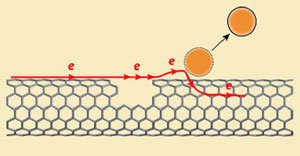Sep 17 2010
According to the US researchers the single-walled carbon nanotube (SWNTs) sensors can be ‘reset’ by simply pressing the switch.
The researchers could identify the organic molecules that are attached to the nanotubes sheds off from the surface upon conduction of electricity through the material, thus regenerating the sensor for further usage.
 Electrons are accelerated across a nanotube defect and collide with molecules on the nanotube surface, shaking them off
Electrons are accelerated across a nanotube defect and collide with molecules on the nanotube surface, shaking them off
These SWNTs can be deployed in highly sensitive, tiny chemical sensing devices for monitoring various chemicals and gases. The SWNTs when adhered to a silicon material, takes in the chemicals to their surface but, most of the chemicals are absorbed in an irreversible manner, which results in an extended processes prior the sensor reusage.
Richard Masel along with his colleagues at the University of Illinois tried to solve the issue by employing current-stimulated desorption (CSD) technique in which a strong electric current is allowed to pass through the SWNTs. Richard Masel reported to the Chemistry World that during the CSD process the electrons drift across the nanotubes, collides with the molecules on the surface, transfers the surplus energy to the absorbed molecule and finally detaches from the surface.
The CSD technique desorbs the chemicals from the surface of nanotube, without increasing the heat or damaging the sensor. The research team has experimented nearly ten identical sensor systems and identified that all the aromatics, amines, alcohols and phosphonates are shaken off from the surface in the similar manner, permitting the sensors to re-generate rapidly for further use.
The specific CSD technology is superior over other methodologies such as photodesorption, in which a UV light source has to be supplied externally to the surface for the desorption of molecules. This inturn is a lengthy process since lower numbers of electrons are desorbed from the surface by providing external light source and also results in very slow resetting of the sensors.
According to Masel sensors can be re-generated rapidly employing the CSD since the electrons are already excited in the nanotubes upon applying voltage and do not require the supplement of any additional source.
Angus Kirkland, carbon nanotube-based material specialist at the Oxford University, UK mentioned that the carbon nanotubes shows remarkable advantages over other materials and will facilitate the fabrication of cost-effective, unique sensing devices for monitoring hazardous organic molecules for wide use in healthcare, security and environmental applications.